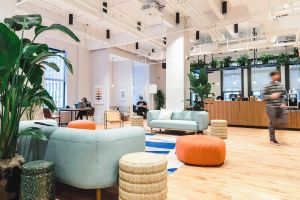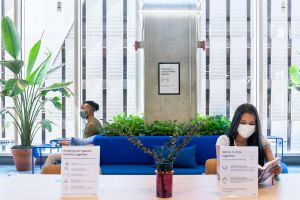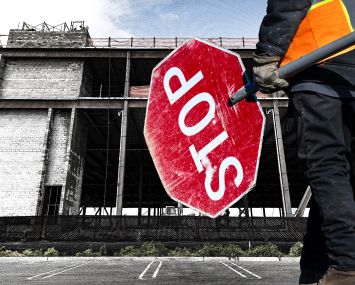Presented By: WeWork
WeWork Looks at the Office Market’s Post-COVID Future

The way people work is changing due to COVID-19, and, as a result, companies are adjusting their office space strategies to meet the current moment. Few companies understand the office market like WeWork, a flexible office space provider with more than 800 locations globally. Since the outbreak of COVID-19, WeWork has worked closely with industry-leading companies worldwide to adapt their workplace strategies and real estate needs in light of the pandemic.
To learn more about how enterprise companies are adapting the way they use real estate, Commercial Observer’s Partner Insights team spoke with Ronen Journo, senior vice president of enterprise and workplace for WeWork.
CO: Let’s start with the short-term perspective. How did WeWork prioritize safety immediately and adapt its locations to ensure members felt comfortable in the space?
RJ: At WeWork, the health and safety of our members and employees is our top priority. We monitored the outbreak closely, and listened to global and local health authorities in order to implement measures for protecting our communities as soon as possible. In all of our locations, we’ve de-densified high traffic areas and modified shared spaces. We also built upon our existing cleaning measures to frequently disinfect common areas and lounges and added sanitization stations throughout our locations. We’re asking that people wear masks in common areas, ensuring that hand sanitizer is available, and where possible, taking people’s temperatures.
We’ve reinforced these new cleaning standards and capacity protocols through strategically placed signage and wayfinding — from designated one-way signs in hallways to capacity signage in meeting rooms. We want to ensure that all of our members feel comfortable in our spaces.

CO: When you talk about de-densification, are we just talking about basic actions like making sure desks are farther apart?
RJ: That, and much more. De-densification also includes working with members to understand the square footage they may now need due to social distancing in the workplace. Whether it’s having a dedicated space for rotating teams or expanding to multiple offices in the same building, our spaces can adjust to fit as few or as many people as needed—making it easy to follow local health and safety guidelines.

CO: Do you think companies are looking at all this solely on a short-term safety basis, or are they evaluating office life in general and making longer-term changes?
RJ: Since April, I’ve been having conversations with heads of real estate at some of the world’s largest corporations, who combined represent more than 6 million people who use offices, to discuss what the long-term implications of this may be. Through these conversations, I’ve learned that there are two distinct schools of thought: Companies that simply see this as an opportunity to accelerate cost-cutting and footprint optimization that began pre-COVID, or companies that say COVID-19 is the biggest change agent for the world of work in a century.
COVID has forced entire economies to shift to a blended virtual and physical operation. Can we learn from this and rethink the way the workforce operates? Many companies are doing that. I’m hearing about cross-functional dialogues between HR, technology, real estate, risk and finance where the organization at large is trying to formulate the new norms for their company. For example, a German energy company I spoke to noted that COVID has enabled their workforce to work from anywhere, and that adds a layer to how they’ll consider managing their people and their real estate moving forward.
I believe we will see major changes in the world of work, but it may take longer than a year for these changes to be at a tangible and measurable level.

CO: What do you think are some of the biggest long-term changes that will emerge from this time period?
RJ: I think the biggest changes we’ll see will happen at the individual level. Pre-COVID, employee engagement was already low, with 70 to 80 percent of people feeling disengaged in what they were doing, according to Gallup data. The average office was also only occupied at around 45 to 55 percent, according to Verdantix, which is very underutilized. Something had to change, and COVID may be the instigator.
I think a huge number of people around the world will be given more flexibility around their workspace options, including how they work, where they work, and how they collaborate. They will be given a choice of how to manage their time and how to reduce their commute. Companies will optimize their footprint more radically to match with the need, and not hang onto space they no longer use. We’re going to see companies buying into the idea of flexibility more than ever before.
At the social level, we will see the death of management by presentism and more emphasis on employees finding locations to work that work better for them.
CO: What is management by presentism?
RJ: Management by presentism is the traditional but outdated concept that managers feel they need their team physically in the building to see that they’re performing their work and producing output.
Recently, we’ve seen tech companies upend this notion, but the vast majority of other industries hadn’t gotten there yet and were still operating in a culture and mindset of needing every employee in one location. Now we’re seeing that change happening to all of us, across all industries. So on a human level and in terms of real estate, we’re going to see fundamental change in how companies manage people. Employees want to congregate somewhere outside of their home, because working from home five days a week is not the answer. People want a sense of community, a sense of belonging.
I think we’ll see a rise in the popularity of having several satellite offices throughout a city that allow employees to congregate at a location closer to them rather than one single corporate HQ. This “hub and spoke” approach will not only shorten commutes, but also continue to put value on physically coming together.
At WeWork, we’ve always emphasized an environment that fosters community and connection. We may no longer see people coming into an office five days a week, but the drive for human connection, even through work, will always be part of the equation.
CO: How do you see COVID-19 impacting the business of office leasing overall?
RJ: In general, we’ve seen companies looking for more flexibility than ever before. I think we’ll also see companies looking to optimize their footprint to be more strategic, and as a result, they may let go of traditional leases in exchange for spaces managed by third-party operators like WeWork.
CO: WeWork just announced WeWork All Access, a new monthly membership that allows individuals and companies to access any WeWork location across the country. Tell me about that.
RJ: WeWork wants to be the partner of choice for all companies, and our flexibility at scale allows us to do that. Wherever and however they need us – short-term solutions, medium-term swing space, long-term headquarters space – we are here to partner with organizations around the world to find solutions that best suit their needs.
WeWork All Access is one of the latest benefits we’ve offered for our members. In the U.S., WeWork is located in 40 cities across 400 buildings with several locations within each city. WeWork All Access gives members the chance to visit convenient locations that make sense for them. This allows businesses to apply the “city as a campus” strategy that benefits not only the company but, most importantly, the employees. Employees can reduce their commute times and have flexibility in their workday while businesses can distribute their workforce thoughtfully, prioritizing their employees’ health and safety while maintaining productivity.
For companies that want to try WeWork All Access, new members in the U.S. and Canada can test drive for 2 weeks free for up to 10 people on their team through Oct. 30. Click here to learn more about WeWork All Access.

CO: To sum up, what does all of this mean for the future of the office?
RJ: Ten years ago, people were liberated from the cubicle and we saw the dawn of the open-air office. Now we’re seeing a revolution where people are allowed to work from home. I think what we’ll see next is people being liberated from any one specific location, either home or office, and being given a choice of how and where to work from wherever it makes sense for them. The idea of “work from anywhere” combined with a drive for community congregation will create new demand for flexible workspace providers. WeWork is prepared to meet that demand through our 800 easily accessible, intentionally designed spaces, and that’s not going away.
To learn more about how the office of tomorrow will work, visit wework.com/brokers


